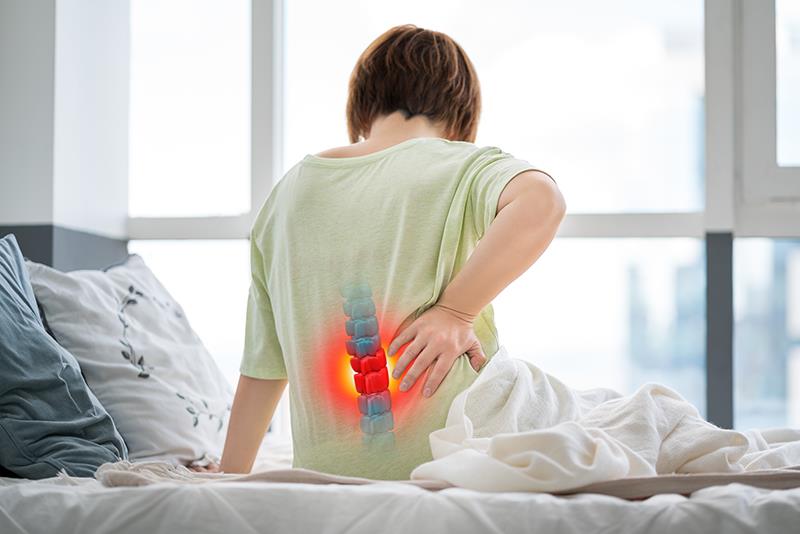Abaloparatide helps prevent fractures in most vulnerable postmenopausal women





Treatment with abaloparatide appears to reduce the incidence of fractures as well as improve bone mineral density (BMD) in the subgroup of postmenopausal women at highest risk of fracture, according to a post hoc analysis of the ACTIVE* study.
Over 18 months of treatment, a new vertebral fracture occurred less frequently among women who received abaloparatide or teriparatide than among those who received placebo (0.72 percent vs 0.99 percent and 4.77 percent, respectively). These numbers translated to a relative risk reduction of 85 percent with abaloparatide and 79 percent with teriparatide vs placebo (p<0.0001 for both). [Menopause 2025;doi:10.1097/GME.0000000000002516]
With regard to other fracture outcomes, the respective estimated Kaplan-Meier cumulative incidence with abaloparatide, placebo, and teriparatide was 3.0 percent, 5.3 percent, and 3.0 percent for nonvertebral fracture; 1.1 percent, 2.1 percent, and 2.1 percent for wrist fracture; 4.0 percent, 9.0 percent, and 4.3 percent for clinical fracture; and 1.6 percent, 6.8 percent, and 3.0 percent for major osteoporotic fracture.
The analysis included 2,026 women (mean age at baseline 69.3 years) enrolled in ACTIVE who met at least one of the following criteria for high fracture risk: (1) fracture within the past 12 months or prevalent vertebral fracture, (2) baseline T score of less than −3.0 at any site, (3) very high fracture risk probability by FRAX (ie, 10-year major osteoporotic fracture of >30 percent or hip fracture of >4.5 percent), and (4) multiple prior fractures at baseline since age ≥45 years.
Of the women, 664 were in the abaloparatide group, 685 in the teriparatide group, and 677 in the placebo group. Treatment was administered via daily subcutaneous injections at a dose of 80 μg for abaloparatide and 20 μg for teriparatide.
Fracture incidence by baseline criteria
Analysis of new vertebral incidence by baseline criteria showed that compared with placebo, both abaloparatide and teriparatide were associated with a significant reduction in fracture risk across subgroups of women with recent fracture in the last 12 months or prevalent vertebral fracture (0.53 percent and 2.48 percent vs 7.73 percent; p=0.0003 and p=0.0144, respectively), those with low T score (0.73 percent and 0.71 percent vs 3.94 percent; p=0.0024 and p=0.0023, respectively), those with multiple prior fractures (0 percent and 2.14 percent vs 9.14 percent; p<0.0001 and p=0.0047, respectively), and those with very high fracture probability by FRAX (0.37 percent and 0.69 percent vs 6.32 percent; p<0.0001 and p=0.0002, respectively).
The risk reduction observed with abaloparatide and teriparatide vs placebo was substantial only in the low T score subgroup and was numerical in the other three subgroups. However, the investigators acknowledged that the study was not sufficiently powered to assess these events in these subgroups.
BMD gains and safety
Participants treated with abaloparatide or teriparatide also showed BMD gains at the lumbar spine, total hip, and femoral neck compared with those who received placebo at all time points (6, 12, and 18 months; p<0.0001 for all).
The increase in BMD was especially greater with abaloparatide vs teriparatide at the lumbar spine at 6 and 12 months (p<0.05) and at the total hip and femoral neck at all time points (p<0.005 for both).
As for safety, the incidence of adverse events (AEs) was similar across the three treatment groups. The most frequent AEs documented among participants in the abaloparatide group were hypercalciuria (11.5 percent), dizziness (11.0 percent), and arthralgia (8.9 percent).
Overall, the efficacy and safety findings were consistent with the overall ACTIVE cohort. [JAMA 2016;316:722-733]
“Abaloparatide is a synthetic, 34-amino acid peptide that selectively binds to the G protein-coupled RG conformation of the parathyroid hormone type 1 receptor, which favours increased bone formation while limiting effects on bone resorption markers,” the investigators said. [JAMA 2016;316:722-733; Endocrinology 2016;157:141-149]
Taken together, the data from the ACTIVE study demonstrate that abaloparatide therapy reduces fracture risk across a range of fracture probabilities, regardless of the definition, they added.
*Abaloparatide Comparator Trial In Vertebral Endpoints